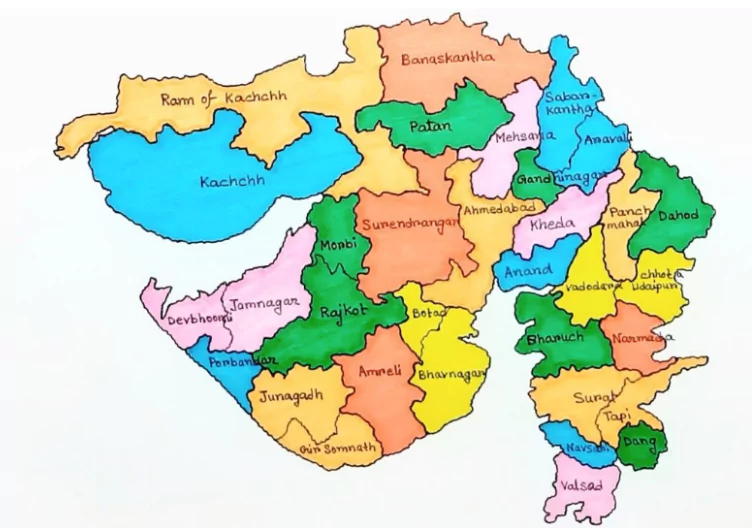A research paper namely, ‘Timely Access to Public Health Facilities for Pregnancy Care in Tribal Gujarat: A Geospatial Analysis’ was released, examining the access to maternal healthcare facilities from a geospatial perspective
- The paper was published in the Economic & Political Weekly, Vol. 59, 2024
Geospatial view on Maternal Healthcare: Key Highlights of the Study

- Target Group: The study focuses on Gujarat’s tribal population, constituting 14.8% of the total population, scattered across 14 districts.
- Dahod, Banaskantha, Sabarkantha, Aravalli, Mahisagar, Bharuch, Surat, Tapi, Dang, Navsari, Valsad, Panchmahal, Chhota Udaipur, and Narmada
- Data Source: The study used GIS data, data from the National Family Health Survey and geocoded health facilities spread across districts with higher concentrations of tribal population
- Modes of Transportation: The authors used various forms of transportation ie. a car, a motorcycle and walking to reach and understand the accessibility of healthcare centres (tertiary, secondary and primary health centres).
- Focus: To provide a visual and quantitative understanding of the distribution of healthcare facilities within tribal regions across these districts and evaluate the extent to which people can access healthcare facilities for timely maternal care through spatial analysis, mapping, and quantitative methods.
Enroll now for UPSC Online Course
- Findings:
- Average Coverage of Pregnancy Care: The paper reveals that the average coverage of pregnancy care in Gujarat’s tribal districts is 88%
- Approximately 80% of women receive antenatal care (ANC), and 90% give birth at healthcare facilities, and 92% receive postnatal care (PNC) for themselves and their infants.
- Regional Disparity: Districts in the north near Rajasthan and northwest near Madhya Pradesh are the worst performing, while the best-performing districts are in the south near Maharashtra.
- Lower ANC coverage: Districts such as Banaskantha, Mahisagar, Sabarkantha, Dahod, and Bharuch record low levels of ANC coverage
- Districts with higher overall pregnancy care rates have also witnessed a neglect of ANC, which is particularly concerning.
- Meeting WHO Standards: Districts including Surat, Tapi, Dang, Navsari, and Valsad demonstrate better pregnancy care outcomes meeting WHO standards.
- The Districts of Banaskantha and Bharuch demonstrate low levels of pregnancy care even falling below the WHO-prescribed thresholds in at least two care indicators.
- Geographical Constraints: Over 50% of households reside more than 25 km away from tertiary care facilities while about 30% of households live away from community healthcare centres and primary healthcare centres limiting women’s access to health facilities even during pregnancy-related emergencies.
- The unavailability of health centres near the tribal hamlets results in inadequate levels of ANC and PNC care after pregnancy.
- Population Bias: Many rural and tribal residents experience inadequate access to healthcare facilities, as resources are concentrated in urban areas to manage the growing population in smaller urban clusters.
- Recommendations of Report:
- Ensuring Accessibility to All: To assess the geographical distribution of the health care centres to ensure that they don’t remain concentrated in specific regions and are distributed equitably across all areas to provide timely access to healthcare during pregnancy.
- To consider both temporal and spatial aspects of healthcare, rather than solely focusing on the traditional factors like population and socio-economic factors.
- Adhering to Established Standards: The distribution of public health centres is expected to adhere to population norms and geographical considerations as per Indian Public Health Standards 2022
- Focusing on making transport facilities available: Social norms and limited resources often prevent women, especially in rural areas, from using motorcycles, and there is limited public transportation available limiting their access to ANC and PNC care.
- Policy Focus: To implement policies that establish well-equipped and affordable public healthcare centres in easily accessible locations with accessible transport options for disadvantaged communities.
Maternal Mortality
- Maternal Mortality Ratio(MMR number of maternal deaths per 100,000 live births): As per the latest report of the national Sample Registration system (SRS) data for the period 2018-20, Maternal Mortality Ratio(MMR) is 97/100,000 live births, declining by 33 points, from 130/ 100,000 live births in 2014-16.
- Between 2000 and 2020, MMR dropped by 70% (from 327 to 97).
- India’s Share Globally: India accounted for over 17% of global maternal deaths in 2020, holding the highest share among the 10 countries responsible for 60% of global maternal deaths, stillbirths, and newborn deaths.
- SDG Target 3.1: India is likely to achieve the global 2030 SDG target of 70 maternal deaths per 100,000 live births, before time.
- Eight states have already achieved the SDG target ie. Kerala (19), Maharashtra (33), Telangana (43) Andhra Pradesh (45), Tamil Nadu (54), Jharkhand (56), Gujarat (57), and Karnataka (69).
Government Initiatives
- Pradhan Mantri Surakshit Matritva Abhiyan: It seeks to improve the quality and coverage of diagnostics and counselling services, along with providing assured comprehensive and quality antenatal care free of cost.
- Poshan Abhiyaan: Pregnant Women are among the major target groups of POSHAN Abhiyaan- the government’s flagship programme to improve nutritional outcomes
- Pradhan Mantri Matru Vandana Yojana (PMMVY): It is a direct benefit transfer (DBT) scheme under which cash benefits are provided to pregnant women in their bank account directly to meet enhanced nutritional needs and partially compensate for wage loss.
- Surakshit Matritva Anushasan (SUMAN): It aims to provide assured, dignified and respectful delivery of quality healthcare services at no cost and zero tolerance of denial of services to any women and new born visiting a public health facility
- Labour Room & Quality Improvement Initiative (LaQshya): The programme is working on improving the quality of care for pregnant women in labour room, maternity Operation Theatre and Obstetrics Intensive Care Units (ICUs) & High Dependency Units (HDUs)
|
Check Out UPSC CSE Books From PW Store
Geospatial Data
- Geospatial data is information recorded with a geographic indicator of some type and describes objects, events or other features with a location on or near the surface of the earth.
- Combination of: Geospatial data combines location information (usually coordinates on the earth) and attribute information (the characteristics of the object, event or phenomena concerned) with temporal information (the time or life span at which the location and attributes exist).
- Types of Geospatial Data: There are two primary forms of geospatial data as below,
- Vector data: In this type of data points, lines and polygons represent features such as properties, cities, roads, mountains and bodies of water.
- For example: A visual representation that uses vector data might include houses represented by points, roads represented by lines and entire towns represented by polygons.
- Raster Data: It is pixelated or gridded cells identified according to row and column. Raster data creates imagery that’s substantially more complex, such as photographs and satellite images.
- Geospatial Analytics: It is used to add timing and location to traditional large sets of spatial data to build data visualizations using maps, graphs, statistics and cartograms that show historical changes and current shifts.
- Examples of Geospatial Data:
- Vectors and attributes: Descriptive information about a location such as points, lines and polygons.
- Point Clouds: A collection of colocated charted points that can be recontextured as 3D models.
- Raster and satellite imagery: High-resolution images of our world, taken from above.
- Census data: Released census data tied to specific geographic areas, for the study of community trends.
- Cell phone data: Calls are routed by satellite, based on GPS location coordinates.
- Drawn images: CAD images of buildings or other structures, delivering geographic information and architectural data.
- Social media data: Social media posts that data scientists can study to identify emerging trends.
|
![]() 10 Jul 2024
10 Jul 2024

